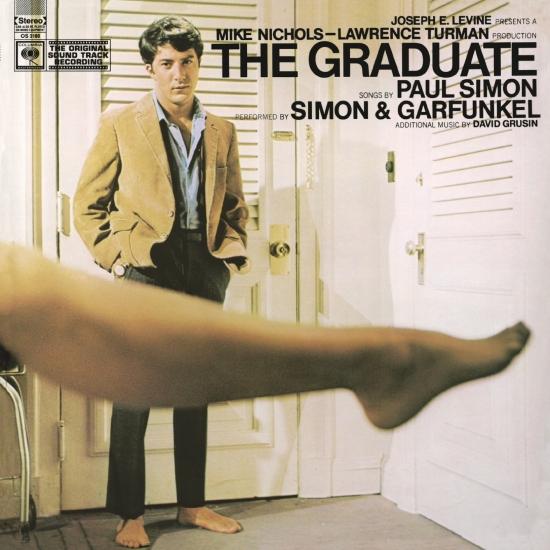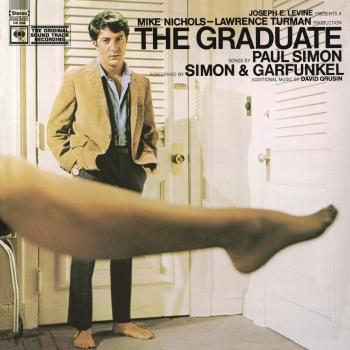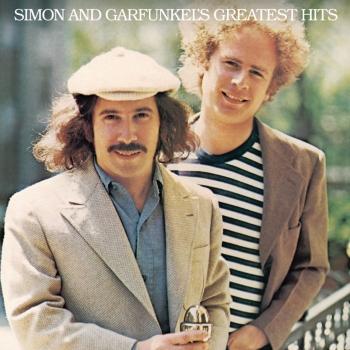
The Graduate (Remastered) Simon & Garfunkel
Album info
Album-Release:
1968
HRA-Release:
24.05.2019
Album including Album cover
I`m sorry!
Dear HIGHRESAUDIO Visitor,
due to territorial constraints and also different releases dates in each country you currently can`t purchase this album. We are updating our release dates twice a week. So, please feel free to check from time-to-time, if the album is available for your country.
We suggest, that you bookmark the album and use our Short List function.
Thank you for your understanding and patience.
Yours sincerely, HIGHRESAUDIO
- 1The Sound of Silence (Electric Version)03:03
- 2The Singleman Party Foxtrot02:50
- 3Mrs. Robinson (Version 1)01:11
- 4Sunporch Cha-Cha-Cha02:51
- 5Scarborough Fair / Canticle (Interlude)01:39
- 6On the Strip01:59
- 7April Come She Will01:48
- 8The Folks02:27
- 9Scarborough Fair / Canticle (Extended Version)06:22
- 10A Great Effect04:05
- 11The Big Bright Green Pleasure Machine (Alternate Version)01:43
- 12Whew02:10
- 13Mrs. Robinson (Version 2)01:12
- 14The Sound of Silence (Reprise)03:08
Info for The Graduate (Remastered)
With his film "The Graduate", which was crowned with an Oscar and five Golden Globes, director Mike Nichols created far more than just the story of the erotic initiation of the college graduate Benjamin. Not only the scenario but also the production modalities were revolutionary. For the very first time the crusted morals of the American upper class were attacked by means of film, an Alfa Romeo – a European car - was advertised most effectively, and a soundtrack was put together from already existent, successful pop numbers. No words are really necessary about the music, since numbers such as "Sound Of Silence", "Mrs. Robinson" and "Scarborough Fair" have entered into the annals of musical culture ever since they were used in the film. It is astounding to note how seamlessly the various works fit snugly into the film’s context, as though they had been specially written for the scenes.
This soundtrack is a monument to Dustin Hoffman, who played his first big role in the film, and it catapulted Simon & Garfunkel right to the top of the list of ballad singers. But it also recalls to memory the peppy, instrumental insertion numbers by Dave Grusin, who virtually fell into oblivion after all the hype about this provocative movie.
"The soundtrack to Mike Nichols' The Graduate remains a key musical document of the late '60s, although truth be told, its impact was much less artistic than commercial (and, for that matter, more negative than positive). With the exception of its centerpiece track, the elegiac and oft-quoted "Mrs. Robinson" -- which only appears here as a pair of fragments -- the Simon & Garfunkel songs that comprise much of the record (a series of Dave Grusin instrumentals round it out) appeared on the duo's two preceding LPs; Nichols' masterstroke was to transplant those songs into his film, where they not only meshed perfectly with the story's themes of youthful rebellion and alienation (and the inner life of the central character, Dustin Hoffman's Benjamin Braddock) but also heralded a new era in movie music centered around the appropriation of past pop hits, a marketing gimmick that grew exponentially in the years to follow. The Graduate soundtrack, then, merits the dubious honor of being the earliest and one of the most successful Hollywood repackagings of "found" pop songs, a formula essentially based around coercing fans to purchase soundtrack albums filled with material they already own in order to acquire the occasional new track or two.
The album began its life because of Nichols' enthusiasm for the duo's music, and Columbia Records chief Clive Davis' ability to persuade the pair of the importance of a soundtrack LP. Davis turned the actual making of the album over to producer Teo Macero, who approached it with skepticism -- Paul Simon and Mike Nichols had discovered that they really weren't on the same page, with Nichols rejecting "Overs" and "Punky's Dilemma," songs that ended up as highlights of the Bookends album, issued two months after The Graduate soundtrack. Thus, there wasn't enough Simon & Garfunkel material to fill even one LP side, and only about eight minutes of that were "new" recordings, and barely a quarter of that (the "Mrs. Robinson" fragments) new song material. And there also wasn't enough of David Grusin's instrumental music (none of which meshed with the duo's work) for an album. Macero combined this material into a musically awkward LP that somehow did its job -- which, in Davis' eyes, was to introduce Simon & Garfunkel's music to the parents of their existing audience (topping the charts in the bargain, and turning Grusin's "Sunporch Cha-Cha-Cha" into a favorite of easy listening stations). Fans of Simon & Garfunkel likely felt cheated by the presence of the "Mrs. Robinson" fragments, as well as repeats of the 1966-vintage "The Sound of Silence" and "April Come She Will," and an edited extension of "Scarborough Fair/Canticle." But there were two curiosities for the completist -- a high-wattage, edited rendition of "The Big Bright Green Pleasure Machine" (in a style seemingly parodying the sound of Bob Dylan's Highway 61 Revisited); and a gentle, subdued acoustic reprise of "The Sound of Silence," which was possibly the best studio rendition the duo ever gave of the song." (Bruce Eder, AMG)
Digitally remastered
 Simon & Garfunkel
Simon & Garfunkel
During the early-’60s era of earnest faux-folkiness, Simon & Garfunkel seemed at first to be utterly typical. Like so many other harmony-enthralled youngsters, they’d cut their teeth on the Everly Brothers, they knew the Great Traditional Songbook as well as the next folk group, and they were driven by the same strivings as the rest of their generation – to get into a good college, to please their parents, to be admired by their peers, and to have some fun along the way. As it turned out, though, Simon & Garfunkel were far from your average folkies. Like so many of their peers, these two natives of Forest Hills, Queens, were musical sponges, but they didn’t leave it at that. Remarkably, they’d broken into the Top 50 as 15-year-olds in 1957 with their Everlys knockoff “Hey, Schoolgirl.” Tom & Jerry, as they then called themselves, even lip-synced the song on Bandstand, but nothing more came of that initial foray into the pop mainstream.
A few years later, Simon moonlighted as a songplugger for publisher E.B. Marks, working in some of the tunes he’d been writing on the side as he pitched songs from the Marks catalog to A&R reps at the labels. While Simon claims that he failed to get even one Marks tune covered, he fared better with his own material. After a live audition, Simon & Garfunkel scored a record deal, courtesy of Columbia Records staff producer Tom Wilson, a jazz specialist (Miles Davis). Wilson heard something in Simon’s overtly poetic songs and Garfunkel’s keening tenor. As it turned out, Wilson was right – but acclaim was still a year, and an album, away. As much as anything, S&G’s 1964 debut album,'Wednesday Morning, 3 A.M.' stands as a distillation of the musical path Paul and Artie had traveled, along with so many of their generation: it’s an unselfconscious pastiche of Everlys-schooled vocal/rhythmic interaction, folk-pop staples, esoterica, English lit-inspired metaphors, and poetic imagery, underlaid with a budding social consciousness. While S&G’s selection and treatment of the outside material was largely unremarkable, the five original tunes made it clear that the two youngsters shared an undeniable gift. Particularly striking was “The Sound of Silence” which, even in its spare acoustic form, came across with the force of a revelation. Interestingly, Simon had begun writing the soon-to-be generational anthem in November 1963, the month President Kennedy was assassinated.
In the spring of 1965, the Byrds, five ex-folkies turned rockers, created a new hybrid that was immediately termed “folk-rock” with their hit cover of Bob Dylan’s “Mr. Tambourine Man.” At that point, Tom Wilson had an epiphany. Taking the all-acoustic recording of “The Sound of Silence” from Wednesday Morning, 3 A.M., the producer brought an electric guitarist and a rhythm section into the studio and proceeded to overdub their parts onto the original track. By late ’65, “The Sound of Silence” was the No. 1 single in America, and Simon & Garfunkel were back together, preparing to make an album relevant to, and worthy of, their first hit. In retrospect, one of the most intriguing aspects of Sounds of Silence is how closely connected it feels to the work recorded during the same period by several other future Hall of Famers: the unabashed romanticism of John Sebastian and his Lovin’ Spoonful (“Kathy’s Song”), the incisive character studies of Ray Davies and his Kinks (“Richard Cory,” “A Most Peculiar Man”) and the soaring loveliness of the Byrds (“I Am a Rock”), whose David Crosby was doing the same sort of inspired arrangements for three or four voices that Garfunkel was coming up with for two. Indeed, the world seemed much smaller then, and Simon & Garfunkel’s music was rapidly being absorbed into the new American vernacular.
By the fall of 1966, when Parsley, Sage, Rosemary and Thyme was released, the nation was in the throes of societal and political upheaval, and Simon vividly, if facetiously, encapsulated that turbulent historical moment on the album’s rollicking sociopolitical send-up, “A Simple Desultory Philippic (Or How I Was Robert McNamara’d Into Submission).” Through the course of the song, Simon name-checked a tumbling litany of names in the headlines, from Martin Luther King Jr. and Gen. Maxwell Taylor to the Beatles and Lenny Bruce, while slipping in a wry reference to the mellowing-out benefits to be derived from a “pint of tea a day” – the kind of tea that was being smoked by ever-increasing numbers of America’s youth. But just as redolent of the times as its subject matter were the sounds of Parsley, Sage, Rosemary and Thyme, from the baroque acoustic guitar figure and celestial Garfunkel vocal that introduced “Scarborough Fair/Canticle,” which opened the album, to their a cappella reading of “Silent Night,” which closed it. If you were a discerning adolescent or young adult in 1966, you not only owned this album, you wore it out – every word, note, and nuance became permanently lodged in your cranium, as listening to it again will readily demonstrate to any War Baby or Boomer with remaining brain cells.
By 1966, S&G had become their generation’s urbane receptacles of hipness and harsh reality alike, assimilating and then embroidering the zeitgeist of a rich and manic era. At the same time, these two artists, as much as any of their peers, held firmly to the unchanging artistic fundaments of precision, clarity, and beauty. Thus, Parsley, Sage contains some songs that cling stubbornly to their moments in time, and others that are simply timeless. Unquestionably, in their exquisitely nuanced arrangement/adaptation of the traditional “Scarborough Fair” (which Simon had learned on a sabbatical to England), along with the Simon-penned “Cloudy,” “Homeward Bound,” “The Dangling Conversation,” and “For Emily, Whenever I May Find Her,” the duo made some of the loveliest recordings of that or any era. That they accomplished all this with their voices, an acoustic guitar, and the sparest of rhythmic underpinning and melodic ornamentation, remains a remarkable achievement.
For more visit: www.simonandgarfunkel.com
This album contains no booklet.












